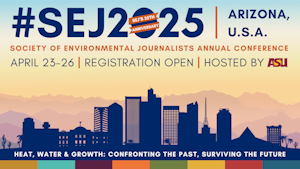SEJournal Online is the digital news magazine of the Society of Environmental Journalists. Learn more about SEJournal Online, including submission, subscription and advertising information.
By TOM HENRY
America has 103 nuclear plants.
Chances are, especially if you work east of the Mississippi River, there's one in your circulation area or one close enough to pose a risk.
How close must it be to pose a risk, consider this: Scientists believe the radioactive fallout from the 1986 explosion of the Chernobyl nuclear reactor near Kiev, Russia was still conceivably strong enough to cause or exacerbate a few cases of cancer in the Pacific Northwest. That's just another reminder that we're all one planet.
You know about America's energy needs. You might know that nuclear power provides 20 percent of our energy now and is second only to that from coal-fired power plants. You may have heard about the nuclear industry's eagerness for a renaissance and the battles on Capitol Hill.
So what's a good way to cover nuclear power, you ask? Fundamentally, it's like anything else: You educate yourself, learn who to trust, stay neutral and hold people accountable.
You remain humble enough to learn more and maintain an insatiable curiosity. You decipher jargon and write eloquently. You separate science from politics while recognizing that both exist. You write with flair and passion without getting flippant or suckered into pure emotion.
You think globally and write locally. You tell people why it matters.
Got it?
Oh, yes, and one more thing.
You wish for luck.
My biggest nuclear story has been the near-rupture of northern Ohio's Davis-Besse nuclear plant reactor head in 2002, the industry's biggest event since half the core of Three Mile Island Unit 2 in Pennsylvania melted in 1979.
Davis-Besse's owner, FirstEnergy Corp., admittedly had been so focused on profits as deregulation emerged in the 1990s that it let errant reactor acid burn the plant's six-inch-thick steel lid down to the width of a pencil eraser.
Eventually, several years of neglected or overlooked maintenance put northern Ohio on the brink of an accident had operators scrambling to keep massive amounts of radioactive steam from escaping and the plant's core from melting.
The story didn't end with the record $33.5 million in fines imposed on FirstEnergy, with $28 million of that coming in January of 2006 when the utility – to avoid criminal prosecution – conceded it had lied to the government about the plant's dangerous condition in the fall of 2001. Three workers accused of lying to the government were indicted; the case has potential ramifications for whistleblowers because one in particular claims to have been set up after trying to get the utility to fix known problems.
Throughout much of that ordeal and even today, five years later, I have been aided in reporting the Davis-Besse story by a Deep Throat-like source inside the plant
I won't, obviously, divulge who he or she is. Let's just say it's a person in a key position who has repeatedly tipped me off about things, documented and undocumented, even before the utility's public relations department or the Nuclear Regulatory Commission has learned of them. We've met each other in person. We have an understanding never to make eye contact or speak to each other in the hallway of a public meeting, even if it's just to exchange pleasantries or chit-chat about the weather. Plus, naturally, I have many other people feeding me information, from citizens to workers to activists to, yes, even industry folks. But nobody like this source.
I've admittedly taken the long way around in getting to the heart of this Covering Nuclear Power 101 story to make a fundamental point: Street cred.
Yes, there's no substitute for credibility on any beat. When it comes to nuclear power, though, you'll have scientists, academics, industry lobbyists, environmental activists, public officials and general know-it-alls trying to read between the lines of your copy for hints of an agenda or to catch you in a dumb mistake, like when a desk editor refers to the stuff coming out of cooling towers as steam instead of water vapor.
Given how emotional and complex nuclear power remains – even more than 50 years after it began with former President Dwight Eisenhower's Atoms for Peace speech – street cred is absolutely essential.
So let's get down to some of the basics:
Study the websites.
• The Nuclear Regulatory Commission (www.nrc.gov) is the federal regulator. Its site has oodles of fact sheets on subjects from reactor operation to waste disposal. You can retrieve transcripts of speeches and find out about anything from upcoming enforcement hearings to public meetings about nuclear topics that may affect your plant or the industry at large.
You'll want to familiarize yourself with the NRC's Agencywide Documents Access and Management System (ADAMS), the agency's primary database for public documents. Agency officials themselves admit it can be a little clunky, although it's gotten better. Don't be afraid to call your regional NRC public affairs officer or the agency's headquarters to walk you through it.
• The Nuclear Energy Institute (www.nei.org) is the industry's Washington-based lobbyist. Its site has a wealth of information from the pro-industry point of view and has people on call 24 hours a day. Yes, you have to tread carefully with the NEI's spin but – in fairness – the same goes for those from the activist community, as well as academia and the government (in this case, that's particularly true: The NRC grew out of the old Atomic Energy Commission, which was heavily involved with promoting nuclear. And many NRC officials are former Navy officers who have been around nuclear for years, though maybe not in a civilian capacity).
• The Union of Concerned Scientists (www.ucsusa.org) is among the most-quoted watchdog groups nationally, in large part because its chief nuclear spokesman, David Lochbaum, grew up being trained as a safety engineer in the industry. Nobody knows the industry and the NRC politics associated with it as well as Lochbaum. He's so good that, well, even actor Paul Newman has been known to have him out at his place. The Nuclear Information and Resource Service (www.nirs.org) and Greenpeace (www.greenpeace.org/usa) also are among the tops in the nuclear watchdog community, meticulously watching what goes on inside the Beltway.
Take the time to read a few books.
There are too many to list here. Many public libraries have the gamut ranging from technical engineering how-to documents to the fringe reactionary stuff. But one you should have on your desk at all times is this: The NRC Information Digest. It's always been a handy reference in a deadline pinch. But the good news is that the 2006-2007 edition (Volume 18, published last August) is the best. It's been expanded to include more visuals and other graphics and has more background about issues than its predecessors. You can flip to the back and find out, for example, the date your local plant went online, the date its 40-year license is due to expire, background on plants that may have been shut down or cancelled, etc.
Visit a plant.
This is not as easy to pull off as it was before the events of Sept. 11, 2001. At one point, a FirstEnergy official said I had vis- Nited so often she thought I qualified to be a tour guide. But tours are still possible. It's a utility-by-utility call (the NRC can't make them let you in). And if you get in, don't make the mistake of thinking you're visiting all 103 plants just because you've visited one. That's one of the drawbacks of the current situation: There are veritably 103 different types of designs. Uniformity: Bad for baseball stadiums; good for nuclear plants. One of the goals of the new age of nuclear, should it come to pass, will be somewhat of a standardized "cookie-cutter" design so parts are more interchangeable and engineers can be cross-trained easier to go from plant to plant.
Besides the variances in designs, America has two distinct types of reactors: Pressurized water reactors and boiling water reactors. The former are more powerful and efficient, but operate at high temperatures and intensity. They're akin to pressure cookers and constitute about two-thirds of our fleet (69 of the 103 plants have pressurized reactors, while 34 have boiling water reactors). Look for the initials PWR or BWR to designate them. For some things, they're regulated differently.
Also, learn if you can go inside containment or not. You'll want to suit up and go inside to get the full experience, if you can. The only time utilities can allow this to happen is when the plants are down for refueling, a major event that happens about once every two years now (due to a higher grade of uranium) and typically lasts only a month to six weeks, at the most (time is money). Be flexible, call in advance and have a window of time available. Although the plant isn't operating when it's being refueled, it's the busiest time for the utility because it is trying to do literally hundreds of jobs it can't otherwise. Call in advance and get an overview of the work that's being done during the outage. Better yet, ask to sit in on one or two of the outage briefings.
Don't just wait to run things by public affairs officers or PR types.
Get to know the different types of engineers and what priorities exist. To wit: As part of my Davis-Besse research, I ended up sitting through several meetings in which metallurgists talked sometimes for up to 12 or 13 hours. Consequently, I learned that a metal alloy called Alloy 600 was used widely throughout the nuclear industry during its construction boom but is not nearly as corrosion-resistant as once thought. It is being replaced by a more robust alloy, called Alloy 690. That may sound like geeky inside baseball stuff for engineers, but it's going to be more of an issue in the future as parts undergo more stress and the issue of metal fatigue becomes more prevalent.
Get to conferences, public meetings and even classrooms whenever you can.
Go online and find the syllabus of a respected nuclear law, history or engineering professor.
Think of how to localize a national nuke story.
This will help get your feet wet and familiarize yourself with some issues, as well as make some contacts. Think there's nothing out there? Check out the proposed rail and shipping routes to Nevada's Yucca Mountain, the potential resting place someday for all of the nation's spent fuel from reactor cores (it's the only thing in civilian hands classified as high-level radioactive waste). The U.S. Department of Energy has published the likely routes. The Ohio Turnpike, for example, which is less than a mile from my house, may wind up with as much as 40 percent of that type of waste that is en route to Nevada. You wanna go low-level? Check on the status of the low-level waste dump being considered by the regional compact that includes your state. Those regional dumps, if ever built, will hold virtually anything radioactive beyond what was pulled from a reactor core, including waste from nuclear plants, hospitals and dental offices.
Become familiar with the following names (and others):
Babcock & Wilcox, General Electric, Framatome, Westinghouse, the Electric Power Research Institute, the Institute of Nuclear Power Operations. They are just some of the industry movers and shakers. There are seven plants with Babcock & Wilcox designs; all run hotter than the industry average and have design issues familiar to the NRC. INPO is the nuclear industry's chief consultant, a clearinghouse of information. While it refuses to talk to the press, you still need to know its influence.
Learn about Three Mile Island, Chernobyl, the Manhattan Project and other historical events of the nuclear age. This will give you some context. Three Mile Island is especially important: It forged the modern era of emergency preparedness plans and even better communication: Believe it or not, there was only one telephone line into the control room when the event was happening in March of 1979. Even then-President Jimmy Carter had trouble getting through. And although the quest to develop civilian nuclear power generation was different than the race to build an atomic bomb, there are parallels you need to understand.
Read a few GAO reports.
The agency changed its named from General Accounting Office to Government Accountability Office a few years ago, but it still has the same abbreviation and website, which iswww.gao.gov. It's the investigative arm of Congress. Search by topic, whether it's security against terrorism (most sensitive material was removed from the public domain, as you might expect) or the status of Yucca Mountain. Get to know some of the key members of Congress. In the House, U.S. Rep. Ed Markey of Massachusetts is the biggest anti-nuke. In the Senate, Majority Leader Harry Reid has been fighting for years to keep Yucca Mountain from getting sacked with the spent nuclear fuel.
Talk to resident inspectors:
The NRC's eyes and ears. Each nuclear plant has two resident inspectors who walk the halls and report their findings to the NRC daily and in longer-term inspection reports (Davis-Besse, at the height of its recent problems, was the nation's only plant to have three). You can find out who they are and get the phone number to their office at the plant off the NRC's staff directory. If you're lucky enough to strike up a rapport with them, you're ahead of the game. But be forewarned they're a tough nut to crack. First, they'll be leery of being quoted. Second, they get moved around. The NRC, to keep them from getting too cozy with the company they're regulating, typically moves them from plant to plant every three years.
If you have two plants in one area, as I do, you may get to know some of the better resident inspectors because the NRC sometimes allows them to spend three years at one site and three years at another nearby, so they are around one area long enough to buy a house. Some wind up being hired by the utilities they've been inspecting; believe it or not, the NRC does not have a consistent policy requiring a break in service.
In any event, it's essential to learn how they operate. Resident inspectors have certain checks they do daily and others that are on a checklist for periods of every two weeks or more. They aren't expected to know everything about a plant's operation, but be there on the front line to find out about the big stuff and get a sense of issues affecting each particular workforce. These are extremely stressful, rigid inspector jobs.
Even with two per plant, it's hard to keep up with the workload. If your plant only has one inspector for an extended time, as Davis-Besse did for nine months before its 2002 problems were revealed, that could be a sign that the inspection workload has become overwhelming and should raise some red flags.
Understand why the nuclear industry has been in the doldrums.
It's not just the post-Three Mile Island regulations. Even the NRC will tell you that applications for new plant construction ceased months before Three Mile Island, due to continued cost overruns. In short, to paraphrase a Clinton-era mantra about the nation's economy: It's the economics [of building new plants], stupid! The agency, after years of robust efforts in Washington to streamline nuclear regulations and provide new incentives, now expects to see the first four or five applications for new construction in almost 30 years this fall, with other applications likely to be submitted in 2008.
In closing, don't get psyched out by the pro-nuke/anti-nuke rhetoric. Yes, it's thick, annoying and enormous.
But the best sources from either side of the fence will recognize you for doing your job as a journalist: Holding people accountable. You'd be surprised, for example, just how much some people in the nuclear industry want their colleagues to be held accountable in the media.
In the Davis-Besse case, I swear I came across as many pronukes in other parts of the country upset about what needlessly happened as I did anti-nukes.
To wit: In a Washington ballroom at the NRC's annual conference in 2005, when I was filing a Davis-Besse story, I was approached by a vice president from a Southern utility who – much to my surprise – lauded me for my coverage. He told me there are many people in the industry who felt Davis-Besse's problems were so avoidable and damaging to his industry that they'd like to take a certain person from the plant "into a dark parking lot and beat the living %#$%" out of him for what he had done to their industry's reputation.
The Nuclear Energy Institute's engineering director, Alex Marion, almost seemed to make a point of letting people know that Davis-Besse wasn't the standard operating procedure for all 103 nuclear plants.
Obviously, if he hadn't, that wouldn't have bided well for his industry.
Thelma Wiggins, one of the NEI's spokeswomen, once passed along that her institute respects me because I"m tough, yet fair. "We know you're going to ask the hard questions that need to be asked, but you'll be fair about it and will do your homework," she said.
So go at it. Do your nuclear research. Play hard. But play fair.
Tom Henry writes for the Toledo Blade.
**From SEJ's quarterly newsletter SEJournal, Spring 2007 issue













 Advertisement
Advertisement 



